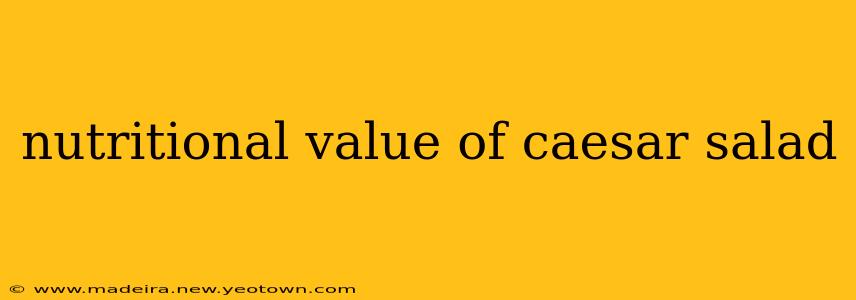The Nutritional Value of Caesar Salad: A Delicious Dilemma?
The Caesar salad. A culinary icon, a lunchtime staple, a creamy, crunchy delight. But beneath its delicious facade lies a nutritional story that's more complex than you might think. Is it a healthy option, or a sneaky source of hidden calories and unhealthy fats? Let's dive into the dressing and uncover the truth about this popular salad's nutritional value.
Our journey begins not with the lettuce, but with the heart of the Caesar salad: the dressing. Traditional Caesar dressing is a creamy concoction of mayonnaise, anchovies, garlic, lemon juice, Worcestershire sauce, Parmesan cheese, and often, a healthy dose of olive oil. This seemingly simple mix can pack a surprising caloric punch, largely due to the high fat content of mayonnaise and Parmesan.
While olive oil provides beneficial monounsaturated fats, the other ingredients contribute significantly to the overall calorie and fat count. The sodium content can also be substantial, especially if you're not careful about the amount of dressing you use. So, the seemingly simple pleasure of a Caesar salad can easily turn into a caloric bomb if portions aren't controlled.
How Many Calories Are in a Caesar Salad?
This is a question with a very flexible answer! The calorie count varies dramatically depending on the size of the salad, the type and amount of dressing used, the additions (like croutons and chicken), and even the restaurant or home cook preparing it. A small, homemade Caesar salad with a light dressing might hover around 200-300 calories. However, a large restaurant version loaded with croutons, chicken, and a generous helping of creamy dressing could easily surpass 700 calories.
Is Caesar Salad Healthy?
This depends entirely on the preparation and portion size. The base of the salad – romaine lettuce – is packed with vitamins A, K, and C, as well as fiber. However, these benefits can easily be overshadowed by the high-calorie, high-fat dressing and the added croutons and protein sources. A lighter version, with a homemade vinaigrette-based dressing using less mayonnaise and olive oil, and fewer croutons, can offer a more balanced nutritional profile.
What are the Benefits of Eating a Caesar Salad?
Despite the potential pitfalls, a well-made Caesar salad can offer some nutritional benefits. The romaine lettuce provides essential vitamins and minerals. Parmesan cheese provides calcium, and anchovies (if included) are a good source of omega-3 fatty acids, albeit in small quantities. The garlic in the dressing provides antioxidants, offering potential health benefits.
However, these benefits are easily diminished by an excessive amount of dressing or added ingredients.
Can I Make a Healthier Caesar Salad?
Absolutely! Making a healthier Caesar salad is all about making smart choices. Here's how:
- Reduce the dressing: Use a lighter hand when applying dressing, or even consider making your own with a blend of olive oil, lemon juice, and Dijon mustard.
- Control the croutons: Opt for whole-wheat croutons, or reduce the quantity.
- Choose lean protein: If adding protein like grilled chicken or shrimp, choose lean options and watch portion sizes.
- Add extra veggies: Boost the nutritional value by adding other vegetables like cherry tomatoes, cucumber, or bell peppers.
The Caesar salad, like many beloved dishes, presents a classic nutritional trade-off. Its deliciousness shouldn't be denied, but mindful preparation and portion control are crucial to enjoying it without sabotaging your health goals. By making thoughtful choices, you can enjoy this classic salad without sacrificing your well-being.

